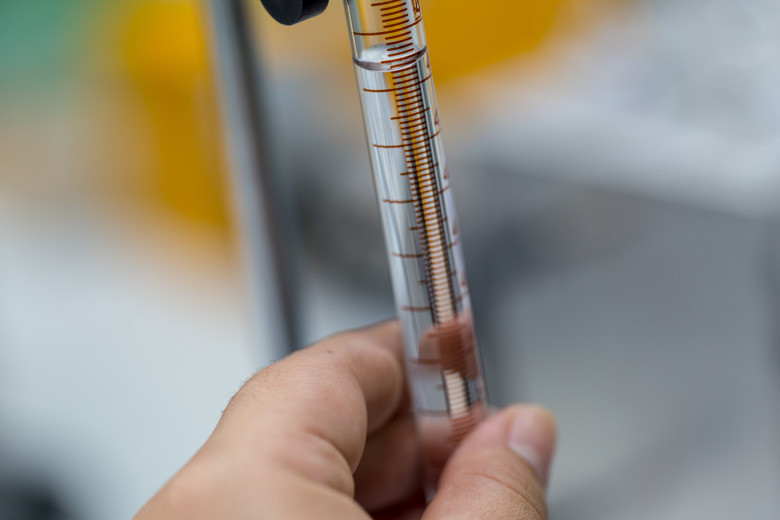Titration Of Sodium Carbonate With Hydrochloric Acid
You can use the technique of titration to determine the concentration of a sodium carbonate solution using a solution with a known concentration of hydrochloric acid, or vice versa. HCl gradually reduces the alkalinity of the solution until the pH is 7. Because the reaction between sodium carbonate and hydrochloric acid proceeds in two stages, you can use more than one indicator. Phenolphthalein is suitable for the first stage, and methyl orange is best for the second.
TL;DR (Too Long; Didn't Read)
Use phenolphthalein for the first titration of sodium carbonate with hydrochloric acid, then check your results by doing a second titration with methyl orange.
A Two-Stage Reaction
A Two-Stage Reaction
When you add a hydrochloric acid (HCl) solution to a solution of sodium carbonate (Na2CO3), the hydrogen ion in HCl switches places with one of the sodium ions in Na2CO3 to produce sodium hydrogencarbonate, also known as sodium bicarbonate (baking soda), and sodium chloride (salt).
Na2CO3(aq) + HCl(aq) → NaHCO3(aq) + NaCl(aq)
Sodium hydrogencarbonate is basic, and it reacts with the HCl still in solution to produce sodium chloride, carbon dioxide and water.
NaHCO3(aq) + HCl(aq) → NaCl(aq) + CO2(g) + H2O(l)
Phenolphthalein is a good indicator for the first reaction because it responds to the pH change caused by the formation of sodium hydrogencarbonate. It is pink in basic solutions and turns colorless as soon as the solution becomes acidic. Methyl orange, on the other hand, responds to pH changes associated with the formation of NaCl, changing from yellow to red as the solution becomes more acidic. At neutrality, it is a distinct orange color.
Basic Procedure
Basic Procedure
Titrations generally call for accurately graduated beakers and pipettes for transferring solution from one beaker to another. Wear goggles and gloves for protection from corrosive chemicals.
1. Prepare the Solutions
Measure out a suitable amount of a sodium carbonate solution of unknown concentration and a hydrochloric acid solution of known concentration in separate graduated beakers.
2. Add Phenolphthalein Indicator
Put a few drops of phenolphthalein in the sodium carbonate solution. The indicator will turn pink.
3. Transfer the Titrant
Carefully add HCl to sodium carbonate solution until the solution becomes colorless. Record the volume of HCl solution you added.
4. Calculate Concentration
Calculate the number of moles of HCl in the original solution and derive from this the number of moles of Na2CO3 in the target solution, keeping in mind that 1 mole of HCl reacts with 1 mole of Na2CO3. Determine the concentration of the Na2CO3 solution using a volumetric analysis.
5. Repeat the Procedure Using Methyl Orange
In this part of the titration, HCl is reacting with NaHCO3, but the proportion is still one mole to one mole. After molarity calculations and a volumetric analysis, the results should be identical to those using phenolphthalein.
References
Cite This Article
MLA
Deziel, Chris. "Titration Of Sodium Carbonate With Hydrochloric Acid" sciencing.com, https://www.sciencing.com/titration-sodium-carbonate-hydrochloric-acid-6511063/. 11 April 2018.
APA
Deziel, Chris. (2018, April 11). Titration Of Sodium Carbonate With Hydrochloric Acid. sciencing.com. Retrieved from https://www.sciencing.com/titration-sodium-carbonate-hydrochloric-acid-6511063/
Chicago
Deziel, Chris. Titration Of Sodium Carbonate With Hydrochloric Acid last modified March 24, 2022. https://www.sciencing.com/titration-sodium-carbonate-hydrochloric-acid-6511063/
